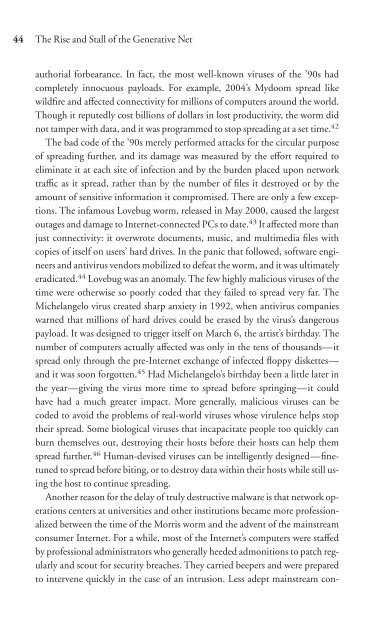Download - Future of the Internet â And how to stop it.
Download - Future of the Internet â And how to stop it.
Download - Future of the Internet â And how to stop it.
Create successful ePaper yourself
Turn your PDF publications into a flip-book with our unique Google optimized e-Paper software.
44<br />
The Rise and Stall <strong>of</strong> <strong>the</strong> Generative Net<br />
authorial forbearance. In fact, <strong>the</strong> most well-known viruses <strong>of</strong> <strong>the</strong> ’90s had<br />
completely innocuous payloads. For example, 2004’s Mydoom spread like<br />
wildfire and affected connectiv<strong>it</strong>y for millions <strong>of</strong> computers around <strong>the</strong> world.<br />
Though <strong>it</strong> reputedly cost billions <strong>of</strong> dollars in lost productiv<strong>it</strong>y, <strong>the</strong> worm did<br />
not tamper w<strong>it</strong>h data, and <strong>it</strong> was programmed <strong>to</strong> s<strong>to</strong>p spreading at a set time. 42<br />
The bad code <strong>of</strong> <strong>the</strong> ’90s merely performed attacks for <strong>the</strong> circular purpose<br />
<strong>of</strong> spreading fur<strong>the</strong>r, and <strong>it</strong>s damage was measured by <strong>the</strong> effort required <strong>to</strong><br />
eliminate <strong>it</strong> at each s<strong>it</strong>e <strong>of</strong> infection and by <strong>the</strong> burden placed upon network<br />
traffic as <strong>it</strong> spread, ra<strong>the</strong>r than by <strong>the</strong> number <strong>of</strong> files <strong>it</strong> destroyed or by <strong>the</strong><br />
amount <strong>of</strong> sens<strong>it</strong>ive information <strong>it</strong> compromised. There are only a few exceptions.<br />
The infamous Lovebug worm, released in May 2000, caused <strong>the</strong> largest<br />
outages and damage <strong>to</strong> <strong>Internet</strong>-connected PCs <strong>to</strong> date. 43 It affected more than<br />
just connectiv<strong>it</strong>y: <strong>it</strong> overwrote documents, music, and multimedia files w<strong>it</strong>h<br />
copies <strong>of</strong> <strong>it</strong>self on users’ hard drives. In <strong>the</strong> panic that followed, s<strong>of</strong>tware engineers<br />
and antivirus vendors mobilized <strong>to</strong> defeat <strong>the</strong> worm, and <strong>it</strong> was ultimately<br />
eradicated. 44 Lovebug was an anomaly. The few highly malicious viruses <strong>of</strong> <strong>the</strong><br />
time were o<strong>the</strong>rwise so poorly coded that <strong>the</strong>y failed <strong>to</strong> spread very far. The<br />
Michelangelo virus created sharp anxiety in 1992, when antivirus companies<br />
warned that millions <strong>of</strong> hard drives could be erased by <strong>the</strong> virus’s dangerous<br />
payload. It was designed <strong>to</strong> trigger <strong>it</strong>self on March 6, <strong>the</strong> artist’s birthday. The<br />
number <strong>of</strong> computers actually affected was only in <strong>the</strong> tens <strong>of</strong> thousands—<strong>it</strong><br />
spread only through <strong>the</strong> pre-<strong>Internet</strong> exchange <strong>of</strong> infected floppy diskettes—<br />
and <strong>it</strong> was soon forgotten. 45 Had Michelangelo’s birthday been a l<strong>it</strong>tle later in<br />
<strong>the</strong> year—giving <strong>the</strong> virus more time <strong>to</strong> spread before springing—<strong>it</strong> could<br />
have had a much greater impact. More generally, malicious viruses can be<br />
coded <strong>to</strong> avoid <strong>the</strong> problems <strong>of</strong> real-world viruses whose virulence helps s<strong>to</strong>p<br />
<strong>the</strong>ir spread. Some biological viruses that incapac<strong>it</strong>ate people <strong>to</strong>o quickly can<br />
burn <strong>the</strong>mselves out, destroying <strong>the</strong>ir hosts before <strong>the</strong>ir hosts can help <strong>the</strong>m<br />
spread fur<strong>the</strong>r. 46 Human-devised viruses can be intelligently designed—finetuned<br />
<strong>to</strong> spread before b<strong>it</strong>ing, or <strong>to</strong> destroy data w<strong>it</strong>hin <strong>the</strong>ir hosts while still using<br />
<strong>the</strong> host <strong>to</strong> continue spreading.<br />
Ano<strong>the</strong>r reason for <strong>the</strong> delay <strong>of</strong> truly destructive malware is that network operations<br />
centers at univers<strong>it</strong>ies and o<strong>the</strong>r inst<strong>it</strong>utions became more pr<strong>of</strong>essionalized<br />
between <strong>the</strong> time <strong>of</strong> <strong>the</strong> Morris worm and <strong>the</strong> advent <strong>of</strong> <strong>the</strong> mainstream<br />
consumer <strong>Internet</strong>. For a while, most <strong>of</strong> <strong>the</strong> <strong>Internet</strong>’s computers were staffed<br />
by pr<strong>of</strong>essional administra<strong>to</strong>rs who generally heeded admon<strong>it</strong>ions <strong>to</strong> patch regularly<br />
and scout for secur<strong>it</strong>y breaches. They carried beepers and were prepared<br />
<strong>to</strong> intervene quickly in <strong>the</strong> case <strong>of</strong> an intrusion. Less adept mainstream con-


